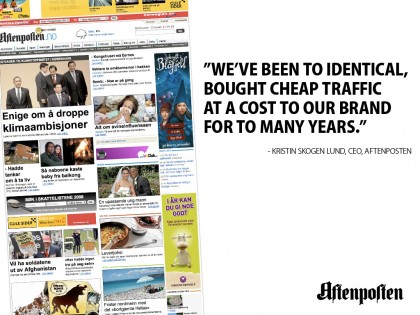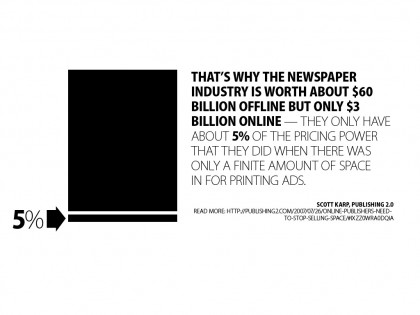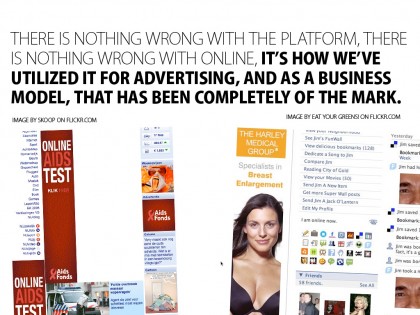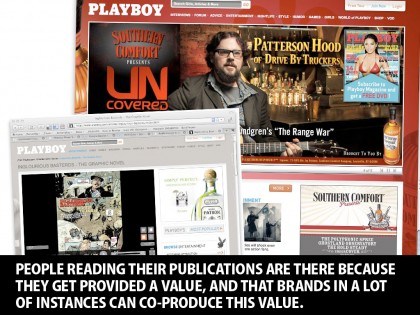Online advertising will change fundamentally during the next year to four years. The reason is more unexpected, and with larger consequences, than anticipated.
I’ve written previously on how both the competition to the online ad product (ie. earned media) and our citizens’ change in online behavior should be forcing online media to innovate its advertising and marketing products. Now it seems these symptoms where only the tip of the iceberg: a change in the fundamental business model of the media industry.
In 2009 media has been failing, and it’s failing fast. All hands are on deck and the ability to think disruptively, not only incrementally, has invited people to rethink the whole structure of their business model. This will affect their income strategies and the companies sponsoring these income strategies.
In other words: online advertising is changing, because the media business model is changing.
This is the case I’m trying to make:
Media has been stuck for some time, but the scalability of the online advertising real estate, and the enormous market has kept the ball rolling. Not sensing that the drive for traffic and the drive for more ad space lessened the editorial product and made the media brands invisible.
As Kristin Skogen Lund, CEO of Aftenposten, one of the biggest newspapers in Norway said at a talk last week:
- - ”We’ve been to identical, bought cheap traffic at a cost to our brand for to many years.” - Kristin Skogen Lund, CEO, Aftenposten
Scott Karp, editor of the Publishing 2.0 blog ads another argument:
- “most newspaper websites sell SPACE for commodity advertising — display ads and classifieds — and thus are hard pressed to compete with ad networks that specialize in selling commodity ad space by the megaton” – Scott Karp, Publishing 2.0

The result is that the display advertising model works just fine for media buyers, but for brands they are receiving a decreasing amount of effect – and compared with the effect from earned media the investment at times can seem as a complete waste. At the same time media companies have brought a knife to a gunfight, they are competing against the networks, a game they can’t win, and are destroying their most valuable possession – their brand – along the way.
So something has got to change!
An incentive for change:
Two important facts where laid out by Skogen Lund at a conference last week:
- Only 5%
Skogen Lund stated that Aftenposten’s online revenue only represented 5% of their total revenue. Scott Karp confirms this as representative for the whole industry:
- “That’s why the newspaper industry is worth about $60 billion offline but only $3 billion online — they only have about 5% of the pricing power that they did when there was only a finite amount of space in for printing ads.” – Scott Karp, Publishing 2.0

Online advertising in it’s current form is not a big revenue model for media companies, which would incentives innovation. If only one believed that online customers where better customers… Are people worse customers online? Hardly, FEED: The Razorfish Digital Brand Experience Report / 2009 states:
- “Brands that use digital to drive awareness also drives sales: 64% of consumers report making a first purchase from a brand because of a digital experience” – FEED 09
So there is nothing wrong with the platform, there is nothing wrong with online, it’s how we’ve utilized it for advertising, and as a business model, that has been completely of the mark.

- Advertising decreasing, subscriptions increasing
A second interesting fact presented by Skogen Lund was a graph showing how advertising has represented a sharp decline in revenue, while subscriptions a sharp increase this last year. This at the same time as we are seeing niche newspapers, with strong brands and identifiable products, increasing their subscriptions in contrary to the mainstream newspapers which are declining. This tells us that there is an interest in a strong media product, and people are willing to pay for it.
My conclusion is this:
Media is a product (a membership), has always been a product and will continue to be a product. But somewhere along the way someone found that sponsoring it with advertising was a god idea. (Brilliant video for Norwegian readers to be found here (Thx. Freddy)). Which it was, to some extent. But the consequence was that the drive for traffic became more important than building a strong brand and a unique product.
Today when advertising sponsorship is failing as a business model, media has to start charging for something. But since they are left with a generic product it is impossible to charge for content that can be found for free ten other places.
(which is probably why Murdoch is shutting out Google, and also the argument of Mathias Dophner here. They want to protect it before they create it.)
So I anticipate that blood will continue to flow in the Media industry – because there is not enough money to finance all these institutions, and there is not enough strong brands to charge for their product.
Which leaves us with advertising: Advertising online will change because the media business model will change. Media brands seeing that they either don’t need to garbage their stories with competing stories, as Scott Karp says:
- “advertising isn’t more valuable when placed next to premium content because display advertising has so LITTLE value to begin with. In fact, display advertising creates so little consumer value that it actually SUBTRACTS value from high quality editorial content when placed next it.”
Or because they find that people reading their publications are there because they get provided a value, and that brands in a lot of instances can co-produce this value. That NEW BRANDS are value creators, and that NEW MARKETING IDEAS are about creating additional value – not a competition between the attention of stories. And that this value, and a relationship built on trust between the media, the brand and the participant, will create a new, valuable, membership based content system.

That brands, as Forrester already has anticipated, will sponsor niche arenas where they can build direct relationships with their participants and members. What these arenas are, how large, small, niche or commercial, content, conversation or context based is completely up to our own imagination and creativity.




















